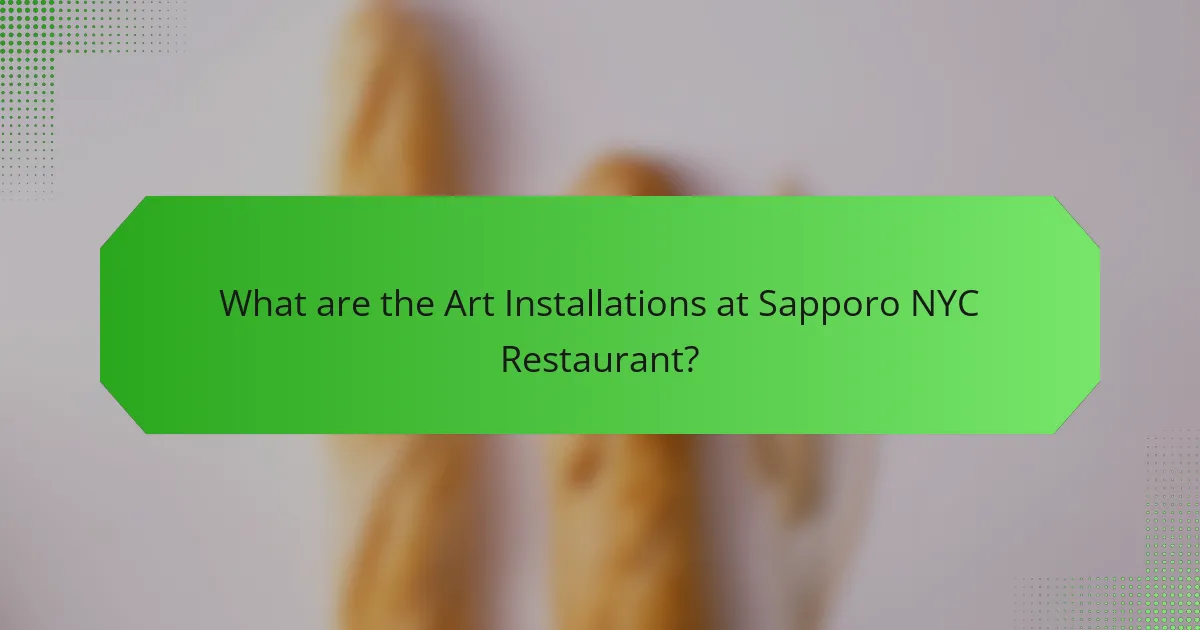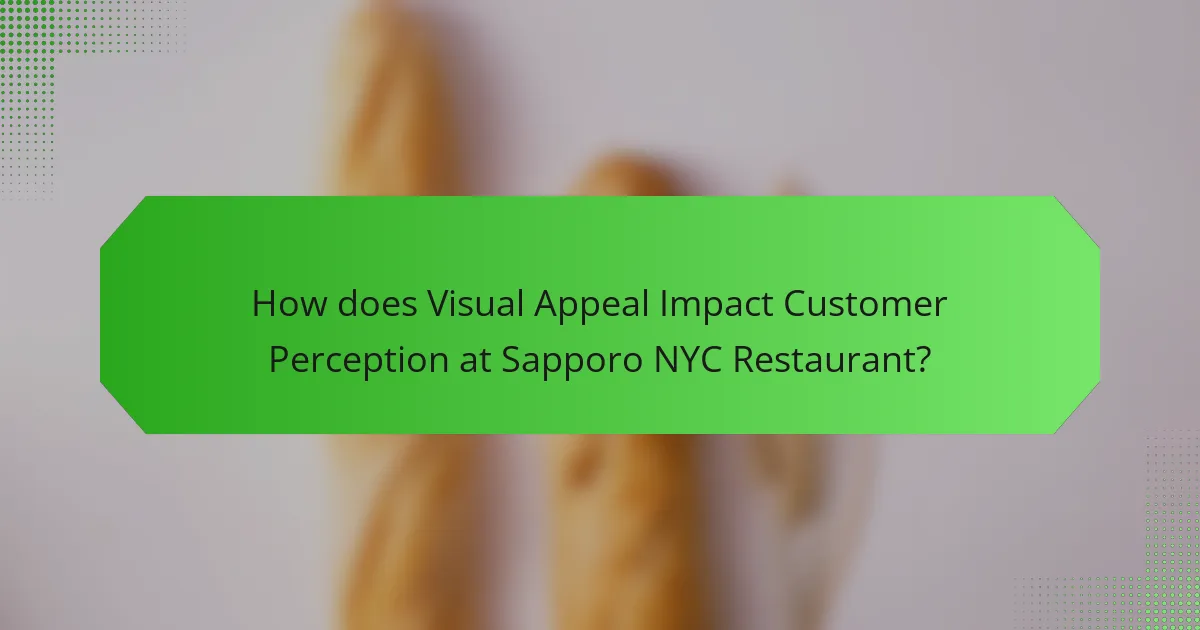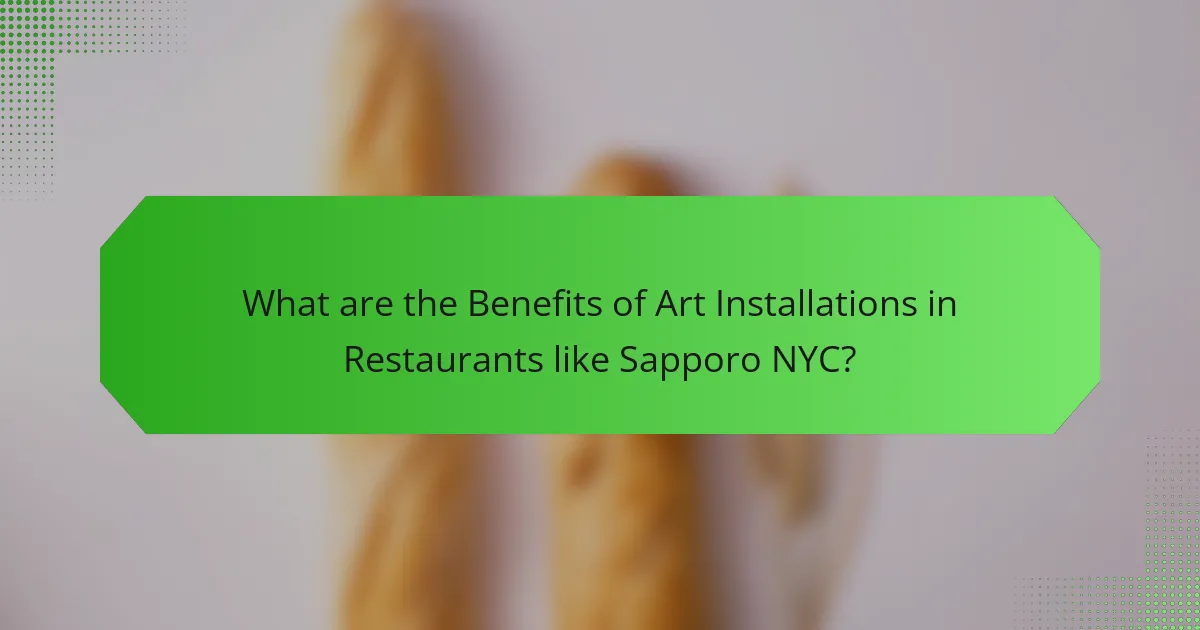
What are the Art Installations at Sapporo NYC Restaurant?
Sapporo NYC Restaurant features a variety of art installations that enhance its ambiance. These installations include contemporary Japanese artwork and traditional motifs. The restaurant showcases pieces from local artists, providing a unique cultural experience. Vibrant murals and sculptures are strategically placed throughout the dining area. The art reflects both modern and traditional Japanese aesthetics. This blend creates a visually appealing environment for diners. The installations contribute to the overall dining experience by engaging guests visually. Each piece is thoughtfully curated to complement the restaurant’s theme.
How do these installations enhance the dining experience?
Art installations enhance the dining experience by creating an immersive atmosphere. They engage customers visually and emotionally. Unique designs stimulate conversation among diners. The installations also reflect the restaurant’s brand identity. This connection can make meals more memorable. Studies show that ambiance influences customer satisfaction. For instance, a pleasing environment can increase the time spent dining. Enhanced experiences often lead to repeat visits and positive reviews.
What types of art are featured in Sapporo NYC Restaurant?
Sapporo NYC Restaurant features contemporary Japanese art. The restaurant showcases paintings and sculptures that reflect Japanese culture. These artworks often incorporate traditional themes and modern interpretations. The ambiance is enhanced by carefully selected pieces that complement the dining experience. The art is curated to create a visually appealing environment. Many pieces are sourced from local artists, supporting the community. This focus on art enriches the overall atmosphere of Sapporo NYC Restaurant.
How often are the art installations updated or changed?
Art installations at Sapporo NYC are updated approximately every six months. This schedule allows for fresh perspectives and keeps the visual appeal engaging for patrons. The restaurant collaborates with local artists to curate new pieces regularly. This practice supports the local art community while enhancing the dining experience. The updates typically coincide with seasonal themes or events. Consistent changes help maintain customer interest and encourage repeat visits.
What themes are explored through the art at Sapporo NYC Restaurant?
The art at Sapporo NYC Restaurant explores themes of cultural fusion and nature. Cultural fusion is represented through a blend of traditional Japanese elements and contemporary artistic styles. Nature themes are depicted through imagery of landscapes, flora, and fauna, reflecting the restaurant’s connection to Japanese aesthetics. The artworks often incorporate vibrant colors and dynamic forms, enhancing the dining experience. This visual appeal complements the restaurant’s culinary offerings. The integration of these themes creates an immersive atmosphere for patrons.
How do these themes reflect the restaurant’s identity?
The themes in Sapporo NYC’s art installations reflect the restaurant’s identity by emphasizing cultural heritage and culinary artistry. The artwork often showcases traditional Japanese elements, reinforcing the restaurant’s commitment to authentic cuisine. This fusion of art and dining creates an immersive experience for guests. Additionally, the visual appeal enhances the ambiance, making it inviting and memorable. The choice of colors and materials in the installations aligns with the restaurant’s modern aesthetic. Overall, these themes effectively communicate Sapporo NYC’s brand values and mission.
What cultural influences are present in the artwork?
The artwork in Sapporo NYC Restaurant reflects various cultural influences. Japanese aesthetics prominently shape the visual elements. Traditional motifs such as cherry blossoms and koi fish are often featured. Additionally, contemporary urban art influences are present. This blend creates a unique visual appeal. The use of vibrant colors and abstract forms showcases modern artistic trends. Cultural symbolism enhances the narrative of the artwork. The integration of these influences fosters a multicultural dining experience.

How does Visual Appeal Impact Customer Perception at Sapporo NYC Restaurant?
Visual appeal significantly impacts customer perception at Sapporo NYC Restaurant. Aesthetic elements such as decor, lighting, and art installations create an inviting atmosphere. This ambiance enhances the overall dining experience, making customers feel more comfortable and engaged. Research indicates that visually appealing environments can lead to increased customer satisfaction. According to a study published in the Journal of Retailing, attractive design can positively influence customers’ emotions and perceptions of quality. Thus, Sapporo NYC’s visual appeal plays a crucial role in shaping how patrons perceive their dining experience.
What role does visual design play in the overall ambiance?
Visual design significantly influences the overall ambiance of a space. It shapes the first impression and guides emotional responses. Effective visual design utilizes color, texture, and lighting to create a cohesive atmosphere. In restaurants, such as Sapporo NYC, design elements can enhance dining experiences. Studies show that well-designed environments can increase customer satisfaction by up to 30%. Visual design also helps convey a brand’s identity and values. This connection can lead to increased customer loyalty and repeat visits. Overall, visual design is a crucial factor in establishing a memorable ambiance in dining establishments.
How does lighting affect the perception of the art installations?
Lighting significantly affects the perception of art installations. It influences how colors, textures, and shapes are viewed. Proper lighting can enhance the visual appeal, drawing attention to specific elements. Conversely, inadequate lighting can obscure details and diminish impact. Studies show that different light intensities can alter emotional responses to art. For instance, brighter light can evoke a sense of energy, while softer light creates intimacy. The direction of light also plays a role; it can create shadows that add depth. Therefore, the choice of lighting is crucial in shaping audience experience and interpretation of art installations.
What colors and design elements are predominant in the restaurant?
The predominant colors in Sapporo NYC restaurant include deep reds, warm browns, and soft whites. These colors create a cozy and inviting atmosphere. Design elements feature traditional Japanese motifs, such as bamboo, and minimalist furnishings. The use of natural materials enhances the overall aesthetic. Lighting is strategically placed to highlight art installations. This combination of colors and design elements contributes to a unique dining experience.
How do customers respond to the visual appeal of Sapporo NYC Restaurant?
Customers respond positively to the visual appeal of Sapporo NYC Restaurant. They often remark on the vibrant colors and artistic decor. The restaurant features unique art installations that enhance the dining experience. Many patrons appreciate the modern and inviting atmosphere. Reviews frequently highlight the aesthetic as a key factor in their enjoyment. The visual elements contribute to a memorable dining environment. Overall, customers feel that the design elevates their meals and encourages repeat visits.
What feedback do patrons provide regarding the art and design?
Patrons provide positive feedback regarding the art and design at Sapporo NYC. Many express appreciation for the vibrant colors and unique installations. Reviews highlight the thoughtful arrangement of artwork throughout the restaurant. Customers often mention how the art enhances the overall dining experience. Some patrons note that the design creates a welcoming atmosphere. The visual appeal is frequently described as modern and culturally relevant. Feedback also indicates that the art sparks conversation among diners. Overall, the art and design contribute significantly to the restaurant’s ambiance.
How does visual appeal influence repeat visits?
Visual appeal significantly influences repeat visits by enhancing customer experience. Aesthetic elements like art installations create an inviting atmosphere. This engagement leads to positive emotional responses. Research shows that 93% of consumers prioritize visual appearance when dining. Attractive visuals can also encourage social media sharing. This sharing increases the restaurant’s visibility. Consequently, more potential customers are drawn to the location. Overall, visual appeal plays a crucial role in customer retention and loyalty.

What are the Benefits of Art Installations in Restaurants like Sapporo NYC?
Art installations in restaurants like Sapporo NYC enhance the dining experience by creating a visually appealing atmosphere. They serve as focal points that attract customers and stimulate conversation. Art can reflect the restaurant’s theme, reinforcing its brand identity. Additionally, art installations can evoke emotions, making the dining experience more memorable. Studies show that visually engaging environments can increase customer satisfaction and encourage repeat visits. Furthermore, unique art pieces differentiate the restaurant from competitors, potentially increasing foot traffic. Overall, art installations contribute to a vibrant ambiance that enhances customer engagement and enjoyment.
How can art installations attract a diverse clientele?
Art installations can attract a diverse clientele by offering inclusive themes and interactive elements. These installations often reflect various cultures and perspectives, appealing to a broader audience. Incorporating local artists can enhance community engagement. Providing immersive experiences encourages participation from different demographics. Research shows that diverse art attracts diverse visitors, as seen in the Museum of Modern Art’s community outreach programs. Additionally, creating a welcoming atmosphere fosters a sense of belonging for all patrons.
What marketing advantages do art installations provide?
Art installations provide unique marketing advantages by enhancing brand visibility and customer engagement. They create memorable experiences that attract visitors. Art can convey brand values and messages effectively. Engaging installations often lead to increased social media sharing. This sharing amplifies reach and promotes organic marketing. Additionally, art installations can differentiate a brand in a competitive market. They contribute to a distinctive atmosphere that enhances customer loyalty. Studies show that experiential marketing, such as art installations, increases customer retention rates by up to 70%.
How do art installations contribute to the restaurant’s brand image?
Art installations enhance a restaurant’s brand image by creating a unique atmosphere. They attract customers and differentiate the establishment from competitors. A visually appealing environment fosters positive customer experiences. This can lead to increased customer loyalty and word-of-mouth referrals. Studies show that restaurants with distinctive art installations often receive higher ratings. For instance, a restaurant’s ambiance can influence dining choices, as highlighted in a 2020 survey by the National Restaurant Association. This indicates that art installations can significantly impact consumer perceptions and brand identity.
What best practices should be followed for incorporating art in dining spaces?
Incorporating art in dining spaces enhances the overall ambiance and guest experience. First, choose art that reflects the restaurant’s theme and cuisine. This creates a cohesive atmosphere. Second, consider the scale of the art. Large pieces can serve as focal points, while smaller works can complement the decor. Third, ensure proper lighting to highlight the art. Well-lit pieces draw attention and create an inviting environment. Fourth, rotate art regularly to keep the space fresh and engaging. This practice encourages repeat visits. Lastly, engage local artists to foster community connections. This not only supports the arts but also creates a unique dining experience.
How can restaurants select art that resonates with their theme?
Restaurants can select art that resonates with their theme by aligning the artwork with their brand identity. They should consider the ambiance and target audience of the restaurant. For example, a modern eatery may choose contemporary art, while a traditional restaurant might opt for classic pieces. Collaborating with local artists can enhance community connections and authenticity. Additionally, art should evoke emotions that complement the dining experience. Research shows that well-chosen art can increase customer satisfaction and dwell time in restaurants. Therefore, careful selection of art can positively impact customer perception and engagement.
What strategies can enhance the visibility and impact of art installations?
Utilizing strategic placement enhances the visibility and impact of art installations. Positioning installations in high-traffic areas attracts more viewers. Incorporating lighting can highlight specific features and create ambiance. Engaging social media campaigns promote installations to wider audiences. Collaborating with local artists can draw community interest and support. Interactive elements encourage audience participation and deeper engagement. Hosting events or openings can create buzz and attract media coverage. Using signage or QR codes provides additional context and information to viewers.
Sapporo NYC Restaurant is the primary entity discussed in this article, focusing on its art installations and visual appeal. The restaurant features a blend of contemporary Japanese artwork and traditional motifs, enhancing the dining atmosphere and engaging customers visually. The article explores how these installations contribute to customer satisfaction, reflect cultural themes, and influence repeat visits. It also addresses the impact of visual design elements, such as lighting and color, on customer perception and the overall dining experience. Additionally, best practices for selecting and showcasing art in dining spaces are outlined, emphasizing the importance of community engagement and brand identity.


